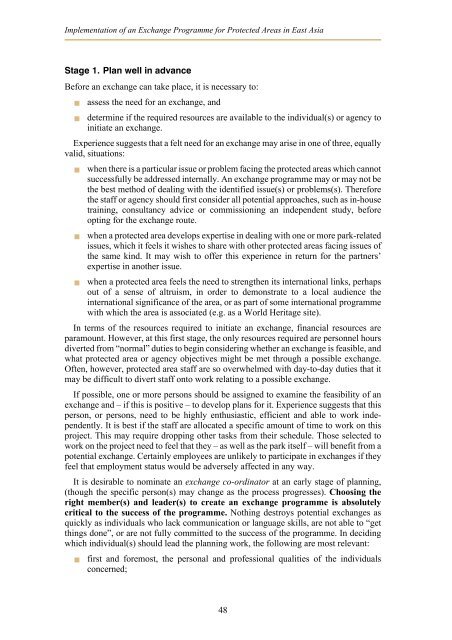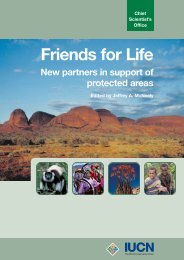Exchange programmes - IUCN
Exchange programmes - IUCN
Exchange programmes - IUCN
You also want an ePaper? Increase the reach of your titles
YUMPU automatically turns print PDFs into web optimized ePapers that Google loves.
Implementation of an <strong>Exchange</strong> Programme for Protected Areas in East Asia<br />
Stage 1. Plan well in advance<br />
Before an exchange can take place, it is necessary to:<br />
� assess the need for an exchange, and<br />
� determine if the required resources are available to the individual(s) or agency to<br />
initiate an exchange.<br />
Experience suggests that a felt need for an exchange may arise in one of three, equally<br />
valid, situations:<br />
� when there is a particular issue or problem facing the protected areas which cannot<br />
successfully be addressed internally. An exchange programme may or may not be<br />
the best method of dealing with the identified issue(s) or problems(s). Therefore<br />
the staff or agency should first consider all potential approaches, such as in-house<br />
training, consultancy advice or commissioning an independent study, before<br />
opting for the exchange route.<br />
� when a protected area develops expertise in dealing with one or more park-related<br />
issues, which it feels it wishes to share with other protected areas facing issues of<br />
the same kind. It may wish to offer this experience in return for the partners’<br />
expertise in another issue.<br />
� when a protected area feels the need to strengthen its international links, perhaps<br />
out of a sense of altruism, in order to demonstrate to a local audience the<br />
international significance of the area, or as part of some international programme<br />
with which the area is associated (e.g. as a World Heritage site).<br />
In terms of the resources required to initiate an exchange, financial resources are<br />
paramount. However, at this first stage, the only resources required are personnel hours<br />
diverted from “normal” duties to begin considering whether an exchange is feasible, and<br />
what protected area or agency objectives might be met through a possible exchange.<br />
Often, however, protected area staff are so overwhelmed with day-to-day duties that it<br />
may be difficult to divert staff onto work relating to a possible exchange.<br />
If possible, one or more persons should be assigned to examine the feasibility of an<br />
exchange and – if this is positive – to develop plans for it. Experience suggests that this<br />
person, or persons, need to be highly enthusiastic, efficient and able to work independently.<br />
It is best if the staff are allocated a specific amount of time to work on this<br />
project. This may require dropping other tasks from their schedule. Those selected to<br />
work on the project need to feel that they – as well as the park itself – will benefit from a<br />
potential exchange. Certainly employees are unlikely to participate in exchanges if they<br />
feel that employment status would be adversely affected in any way.<br />
It is desirable to nominate an exchange co-ordinator at an early stage of planning,<br />
(though the specific person(s) may change as the process progresses). Choosing the<br />
right member(s) and leader(s) to create an exchange programme is absolutely<br />
critical to the success of the programme. Nothing destroys potential exchanges as<br />
quickly as individuals who lack communication or language skills, are not able to “get<br />
things done”, or are not fully committed to the success of the programme. In deciding<br />
which individual(s) should lead the planning work, the following are most relevant:<br />
� first and foremost, the personal and professional qualities of the individuals<br />
concerned;<br />
48






